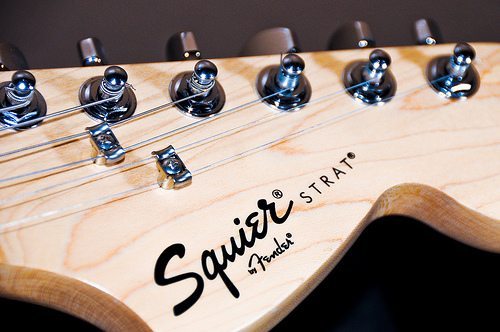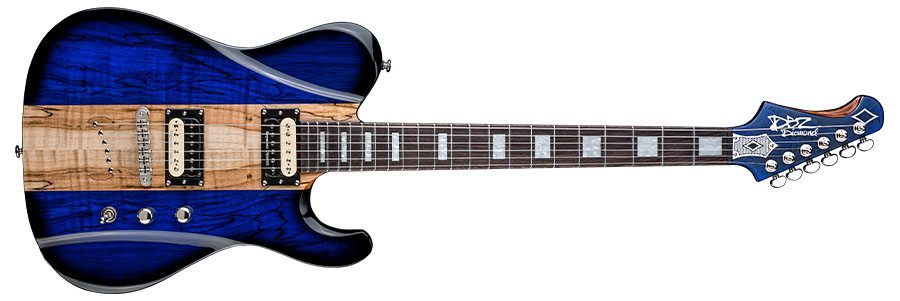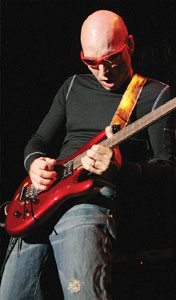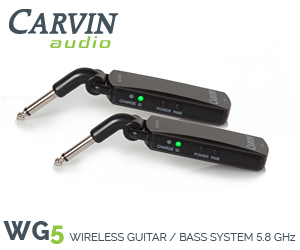New Guitar Day: Five Kinds of Guitars Every Guitarist Should Own
trushack | May 08, 2014 | Comments 7
No one reading TheToneKing.com will disagree with the notion that playing the guitar is one of life’s special experiences. The guitar is more than just an instrument; it’s a work of art with the capability to offer the player a world of different, tangible experiences; different styles, different tones, different materials, different feel, and different looks.
It also offers players a uniquely joyful experience that rivals many other events out there (at least if you’re a guitar player): New Guitar Day (NGD). No doubt one of the great examples of just how spine-chillingly excited NGD can be is the unboxing of the Carvin Tone Dragon.
With as much the guitar has to offer, I believe guitar players are well-served to have as broad an experience with the instrument as possible. So, I’ve devised a list that I think does exactly that: the five kinds of guitars every guitar player should strive to own.
Now, some clever TTK readers may see this list and say something like “I have a guitar that checks off three of these five categories,” or “I could buy five Fender Stratocasters that cover each of these categories, so technically I could complete this list with one kind of guitar, so there!” While I don’t dispute it’s possible, even desirable, to approach guitar ownership that way, it’s not keeping within the spirit of the list. The idea isn’t to find shortcuts, it’s to have the broadest instrument-based experience possible and maximize the number of euphoria-inducing NGDs in your life. I’m also purposely focusing exclusively on electric guitars, though the same principles can apply to acoustic players.
The Classic – The Gibson Les Paul, SG, Explorer and Flying V. The Fender Stratocaster and Telecaster. The Grestch 6120 and White Falcon. The Epiphone Casino. The B.C. Rich Mockingbird. The Ibanez RG and JEM series All of these guitars are classics that have carved out their own special place in guitar lore. Owning a classic gives you a special, personal connection to the many milestones in the history electric guitars and music in general. All of these guitars played major roles in developing the tunes and tones that inspired many guitarists to pick up the instrument
The “Sports Car” – Even if 99% of the music you play is right at home in a polka hall, I believe that every guitar player should have a souped-up, tricked-out shred machine built for speed. The Jackson Soloist, Ibanez JS series, Carvin DC series, Charvel San Dimas and selections from relative newcomers like Halo are all designed with dexterity in mind. Guitars that provide effortless playability and searing tone are not only fun to play but great machines for inspiration, helping you push the limits of your technical ability.
 The “Bargain Bin Special” – For most guitar players, the first electric instrument they ever owned was a modest affair. It may have looked like a Strat or a Flying V, or even some weird mutation or inbred offspring of other classic models. But the point was, we had arrived. We now could make that gargantuan, irresistible noise we’d been hearing on the radio that and been captivating us for who knows how long. Naturally, as we became better or more educated (surely, TTK is helping many players in the Internet age progress), our eyes started to drift towards fancier, more popular models. But those first guitars are still special and still bring back great memories. And even for those players that didn’t start out on a “lower end” instrument, lower priced models like Squier’s Classic Vibe series and the Epiphone line are putting out guitars with amazing bang for the buck. The “Bargain Bin Special” is a great way for guitarists to add another flavor to their tonal stable without breaking the bank.
The “Bargain Bin Special” – For most guitar players, the first electric instrument they ever owned was a modest affair. It may have looked like a Strat or a Flying V, or even some weird mutation or inbred offspring of other classic models. But the point was, we had arrived. We now could make that gargantuan, irresistible noise we’d been hearing on the radio that and been captivating us for who knows how long. Naturally, as we became better or more educated (surely, TTK is helping many players in the Internet age progress), our eyes started to drift towards fancier, more popular models. But those first guitars are still special and still bring back great memories. And even for those players that didn’t start out on a “lower end” instrument, lower priced models like Squier’s Classic Vibe series and the Epiphone line are putting out guitars with amazing bang for the buck. The “Bargain Bin Special” is a great way for guitarists to add another flavor to their tonal stable without breaking the bank.
 The Extended Range Instrument – Has the availability of seven, eight and twelve strings models ever been greater? There was a time when it seemed like the now-classic Ibanez Universe was the only game in town in terms of mass-production seven strings and Rickenbacker had the market cornered on the twelve-string electric sound. But now guitarists enjoy a multitude of options to satiate their extended range dreams at pretty much any price point. No doubt you saw the amazing things Schecter is doing with twelve-string electric design when TheToneKing.com reviewed the T S/H12 Classic. At the other end of the price spectrum, Carvin will build the custom seven, eight or twelve string guitar of your dreams for a price that rivals many production instruments. Extended range guitars are particular useful for exploring new tunings and providing musicians new avenues of creativity in songwriting. When I play my Ibanez RG7321 or Rickenbacker 660/12, I feel like I’m picking up a completely new instrument, instead of just a guitar with an extra string (or strings, in the case of the Rick). Extended range instruments are a great way for guitarists to explore new musical territory with the playing skills they already have.
The Extended Range Instrument – Has the availability of seven, eight and twelve strings models ever been greater? There was a time when it seemed like the now-classic Ibanez Universe was the only game in town in terms of mass-production seven strings and Rickenbacker had the market cornered on the twelve-string electric sound. But now guitarists enjoy a multitude of options to satiate their extended range dreams at pretty much any price point. No doubt you saw the amazing things Schecter is doing with twelve-string electric design when TheToneKing.com reviewed the T S/H12 Classic. At the other end of the price spectrum, Carvin will build the custom seven, eight or twelve string guitar of your dreams for a price that rivals many production instruments. Extended range guitars are particular useful for exploring new tunings and providing musicians new avenues of creativity in songwriting. When I play my Ibanez RG7321 or Rickenbacker 660/12, I feel like I’m picking up a completely new instrument, instead of just a guitar with an extra string (or strings, in the case of the Rick). Extended range instruments are a great way for guitarists to explore new musical territory with the playing skills they already have.
 The “Soul Mate” – Each of the previous categories have tapped into a familiar aspect of electric guitar design and history. But while I clearly believe there are important reasons for owning each of the previous four categories of instrument, this fifth category may be the most important. I believe that every guitar player out there has a unique guitar “soul mate” out there. Not a familiar model that everyone else out there plays, but an instrument that is uniquely yours, whether it be a custom-built model with every last detail specified by you, to an obscure design built by a major manufacturer that never caught on with the wider public. Something that, despite stands out not only in your collection, but in the practice room or onstage. For me, that guitar is a 1990 Telecaster Plus, which I received for Christmas in 1991 or 1992. It’s not a completely unknown model; Johnny Greenwood from Radiohead has used a Tele Plus just like mine for nearly the entire existence of the band. And yes, technically it is a “Classic” being a Telecaster (though, if I’m being a stickler, it’s really just Tele in name only and features none of the classic Tele design elements, except for the body and headstock). But really, it’s just “my guitar.” It feels and sounds like it was made for me. When I was regularly playing the local club circuit, even as a Telecaster it stood out from crowd and always generated curiosity among fellow guitar players. It just wasn’t a common model, even when it was being made, and that made it feel even more special and unique.
The “Soul Mate” – Each of the previous categories have tapped into a familiar aspect of electric guitar design and history. But while I clearly believe there are important reasons for owning each of the previous four categories of instrument, this fifth category may be the most important. I believe that every guitar player out there has a unique guitar “soul mate” out there. Not a familiar model that everyone else out there plays, but an instrument that is uniquely yours, whether it be a custom-built model with every last detail specified by you, to an obscure design built by a major manufacturer that never caught on with the wider public. Something that, despite stands out not only in your collection, but in the practice room or onstage. For me, that guitar is a 1990 Telecaster Plus, which I received for Christmas in 1991 or 1992. It’s not a completely unknown model; Johnny Greenwood from Radiohead has used a Tele Plus just like mine for nearly the entire existence of the band. And yes, technically it is a “Classic” being a Telecaster (though, if I’m being a stickler, it’s really just Tele in name only and features none of the classic Tele design elements, except for the body and headstock). But really, it’s just “my guitar.” It feels and sounds like it was made for me. When I was regularly playing the local club circuit, even as a Telecaster it stood out from crowd and always generated curiosity among fellow guitar players. It just wasn’t a common model, even when it was being made, and that made it feel even more special and unique.
So that is my path to guitar ownership nirvana. What’s yours? Tell us in the comments!
Tiny URL for this post:
Filed Under: Featured • News • Commentary / Editorials
About the Author:






















